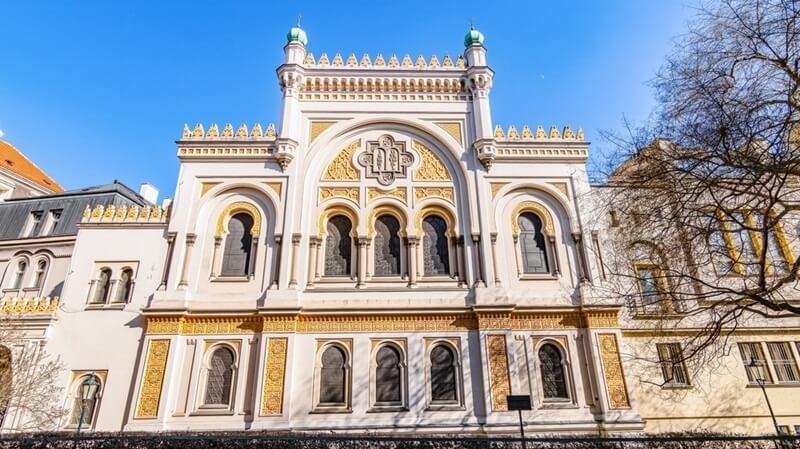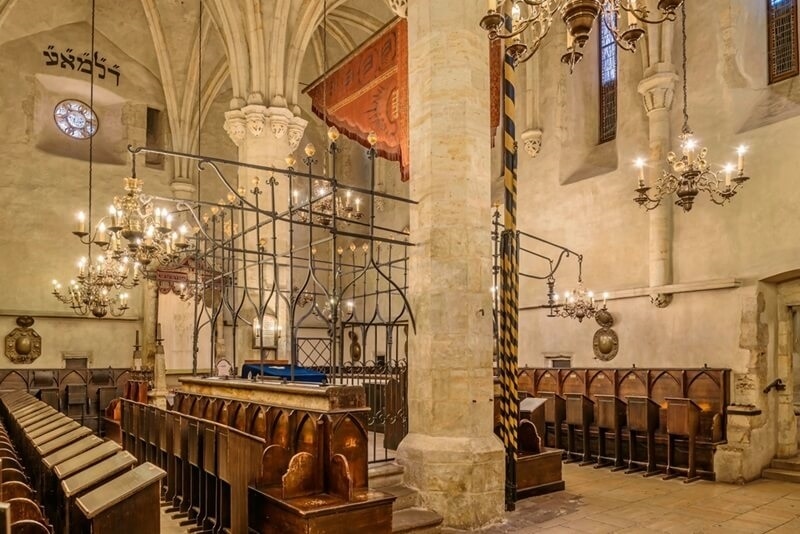
There’s a kind of silence you only find inside very old places — the kind that hums softly beneath stone arches and lingers in air heavy with memory. That silence lives inside the historic synagogues Europe holds so carefully within its cities.
They’re not just old buildings. They’re keepers of stories — some joyful, some painful — each tied to centuries of Jewish faith and survival. From the grand domes of Budapest to the shadowed streets of Prague, every synagogue tells a tale. Step into one, and you’ll feel the past reach out quietly, without words.
If you’ve ever wanted a journey that’s part history, part soul-searching, and part art appreciation, exploring these sacred spaces is an experience that leaves a mark.
It’s easy to think of Europe as a continent of castles and cathedrals. But tucked between those postcard landmarks are places that speak more softly — yet often more powerfully. The historic synagogues Europe preserves are windows into a community that helped shape Europe’s cultural heart long before borders hardened.
Many have been rebuilt after wars. Some were nearly erased, others miraculously untouched. What they share is resilience — not just architectural, but human. Standing inside one, you can almost feel the persistence of faith, artistry, and belonging.

If there’s a single place that captures Jewish endurance, it’s this one. The Old-New Synagogue in Prague is believed to be the oldest working synagogue in Europe, dating back to the late 13th century. Its heavy stone walls and vaulted ceilings look almost medieval — because they are.
According to legend, the Golem of Prague — a mythical clay guardian created by Rabbi Loew — lies resting in its attic. The story alone draws visitors by the thousands, but what keeps them there is the energy. You can sense centuries of prayer still echoing faintly between the pews.
It’s one of the oldest synagogues to visit in Europe that isn’t just historical; it’s alive.
Budapest’s Great Synagogue isn’t subtle — it’s breathtaking. The largest in Europe, its Moorish Revival architecture mixes gold, red, and intricate patterns that make you stop mid-step. But beneath that splendor lies remembrance.
Just outside stands the Holocaust Memorial, a steel weeping willow tree engraved with the names of victims. Each leaf glints in the sunlight like a tiny tear. Inside, light filters through stained glass onto richly carved wood. It’s beautiful, yes — but it also holds space for grief.
Few buildings balance grandeur and gravity as perfectly as this one.
Yes, back to Prague again — because that city feels like a living museum of Jewish heritage. The Spanish Synagogue, built in the 19th century, might be the most visually stunning of them all. Its interiors shimmer with golden arabesques and Moorish-style detail that almost seem to dance in candlelight.
It’s part of the Jewish Museum complex, which includes exhibits tracing centuries of Jewish life in Bohemia. Even if you know little about Jewish faith travel in Europe, this site makes you feel it — the perseverance, the artistry, the pride.
Spain’s Jewish legacy still breathes softly through Toledo’s narrow streets. The Synagogue of El Tránsito, dating back to the 1300s, is a masterpiece of Sephardic culture. Delicate stucco patterns and Arabic-inspired designs cover its walls — a striking reminder of the coexistence that once defined medieval Spain.
Today, it’s part of the Sephardic Museum, honoring Jewish life before the 1492 expulsion. Walking through it feels like visiting a fragment of a vanished world. The craftsmanship, the verses etched into stone — it all stands as both beauty and elegy.
It deserves a spot high on any list of the oldest synagogues to visit in Europe for its haunting grace alone.
Italy’s synagogues blend devotion with design, and Florence’s is the perfect example. Finished in 1882, its copper-green domes rise boldly against the skyline. Step inside, and you’re greeted by rich mosaics, marble pillars, and sunlight streaming through arched windows.
It’s often overlooked by tourists racing toward cathedrals, but anyone taking part in heritage synagogues tours will tell you it’s unforgettable. The mix of Italian craftsmanship and Middle Eastern influence feels symbolic — East meeting West, faith meeting art.
You leave with the quiet thought that beauty itself can be a form of resilience.
Rome, a city known for its grandeur, hides another kind of marvel in its Jewish Quarter. The Great Synagogue of Rome was completed in 1904, symbolizing a new era of freedom for Jews after centuries of segregation.
The building blends Art Nouveau with hints of Babylonian style, standing proudly near the Tiber River. Inside, golden ceilings and ornate frescoes glow warmly, while the nearby Jewish Museum tells stories that stretch back over 2,000 years.
For travelers interested in European Jewish history sites, this one feels essential. It’s a symbol not only of faith but also of the right to exist and celebrate it openly.
Poland’s Jewish history is profound and heartbreaking, and the Tykocin Synagogue captures that duality. Built in 1642, it survived the Holocaust almost untouched. Today, its baroque interior — all soft pastels and Hebrew inscriptions — stands quietly as both a museum and a memorial.
It’s smaller than the famous ones in big cities, but maybe that’s its strength. The intimacy of the space makes it easier to imagine life before the war: the chatter, the songs, the laughter. For travellers tracing European Jewish history sites, this stop feels deeply personal.
Portugal’s Kadoorie Mekor Haim Synagogue in Porto tells a story of renewal. Completed in the 1930s, it symbolises Jewish life returning after centuries of persecution. Its clean lines and simple grandeur reflect optimism more than opulence.
Visitors can tour its museum, attend cultural events, or simply sit in the quiet garden outside. For those who travel for meaning, not just sights, this place resonates. It’s one of those hidden gems that makes Jewish faith travel europe feel intimate and real.
If you’re planning your own journey, here are a few visiting synagogues abroad tips to keep in mind:
These little gestures matter. They show that travel isn’t just about seeing—it’s about honouring.
Planning heritage synagogues tours isn’t complicated, but it helps to mix famous sites with smaller towns. Start in Prague or Budapest, then branch out to lesser-known gems like Dubrovnik or Carpentras in France.
Guided tours can add context, but don’t underestimate the joy of wandering on your own. Sometimes, the most memorable discoveries happen when you take a wrong turn and stumble into a quiet courtyard or an old Jewish cemetery.
Every stop adds a new layer to your understanding of Europe’s Jewish story.
You don’t have to be Jewish to feel something deep in these places. Maybe it’s the way sunlight touches worn stone, or the way silence fills a room. Visiting these synagogues reminds you how faith endures — even when history turns brutal.
For many travellers, these spaces represent something beyond religion: resilience. They survived wars, persecution, and neglect, and they’re still here, waiting for visitors who’ll listen.
It’s impossible to stand inside a centuries-old sanctuary and not feel a little humbled. You realise you’re walking through history that refused to disappear.
Travelling through Europe’s synagogues isn’t a typical vacation. It’s slower, more reflective. You’re not chasing checklists; you’re connecting dots — between art and faith, sorrow and beauty.
Each synagogue, whether it’s grand or modest, tells the same story in its own language: survival. That’s what makes exploring the historic synagogues Europe preserves such a moving experience. It’s not just about architecture or religion; it’s about what people chose to protect, even when everything else was being taken away.
So next time you’re exploring Europe’s cultural map, look beyond castles and cathedrals. Step into one of these quiet sanctuaries. Take a seat, close your eyes, and just listen. The walls will do the talking.
This content was created by AI